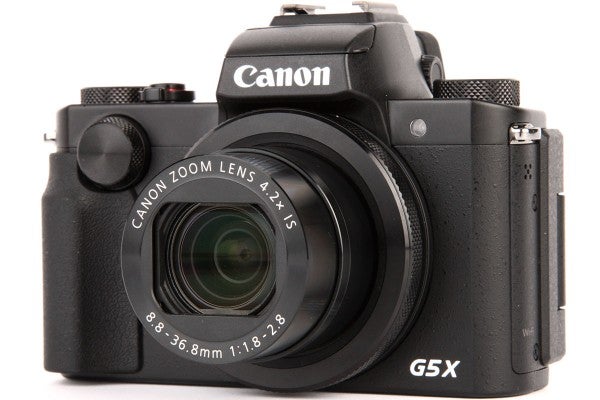With a wealth of physical controls, the Canon PowerShot G5 X is aimed squarely at the enthusiast photographer. Callum McInerney-Riley tests it out
Canon PowerShot G5 X review
Build and handling

A dial on the front and ring around the lens are used to change key settings
When Canon brought out the G5 X and the G9 X, they were designed to sit either side of the G7 X. The G9 X was a smaller and simpler version of the G7 X, while the G5 X was designed to be a bigger camera with more manual controls.
The G5 X has a feel that would suit the discerning enthusiast photographer, being more akin to a DSLR than it is to a point-and-shoot compact. On the front is a large rubberised hand grip, which is curved and tapers off towards the lens. At the rear of the camera is a large thumb grip that is moulded inward towards the exposure-compensation dial. These make the camera comfortable to hold, carry and shoot with.
Overall, the G5 X trumps both the G7 X and its main competitor, the Sony RX100 IV, for the best user experience. However, in the size department the G5 X is considerably larger than either, measuring 112.4×76.4×44.2mm and weighing 377g, so it can’t be slipped into the pocket of a pair of jeans with ease. While I was using it, I carried it in my coat pocket. This is fine in winter, but when the jackets are back in the wardrobe in spring and summer, the camera will probably require a carry strap or a case to house it. For me, what the G5 X loses in portability it makes up for in usability, but the G7 X and G9 X may be better options for those who are put off by the G5 X’s size.

The top plate hosts exposure mode and exposure compensation dials
At the front of the camera is an unusual-looking dial that is used to adjust core settings. Due to the shape of the camera, I found I didn’t use my forefinger to operate it. Instead, I opted for to use my middle finger while having my forefinger on the shutter, and index and little finger gripping the camera. It sounds strange, but it is a comfortable set-up.
On the top of the camera is a large exposure-compensation dial, which is controllable from ±3EV in 1⁄3-stop increments. It’s a fantastic asset to the camera.
Around the lens is another control ring, which, by default, allows users to change aperture in manual mode. At the rear of the camera is a D-pad that doubles as a scroll wheel. Inside shooting menu 2 is a sub-menu called function assignment. This allows users to activate and assign aperture, ISO, manual focus and shutter speed to the various dials. It’s also possible to assign different functions in Av, Tv and Manual modes. In the same menu are numerous button assignments that allow photographers a wealth of customisation options to tailor the camera to their preference. I assigned the zoom to the lens control ring instead of using the lever around the shutter button.

All of the settings and menus can be controlled using Canon’s excellent touchscreen interface
For those users who like to rely on a touchscreen interface for changing control, this camera has that option. However, with the huge number of buttons I found myself relying on the touchscreen relatively little. I used it mainly to operate the quick menu and set the autofocus point, but these can just as easily be done using buttons on the camera’s back in concert with the D-pad. In general, it’s not a go-to method for changing settings.
Overall, the buttons aren’t too fiddly and are well placed around the body, which isn’t always the case with compact cameras. The touchscreen and quick menu resemble that of Canon’s other compact cameras, while the main menus are all colour coded and well laid out much as they are on Canon’s DSLRs. Anybody coming from an EOS DSLR will feel right at home using this camera, and I think Canon menus are among the easiest to use. Nothing is too cluttered and they’re easy to navigate, making customising and tweaking the camera simple. It’s also worth noting that there’s the option to create your own My Menu to collate all your most frequently changed options into a single menu.





